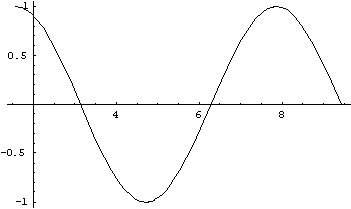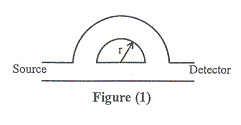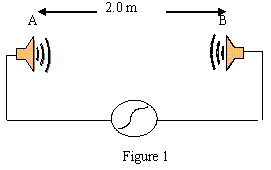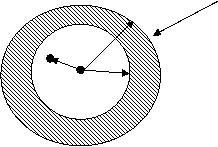Quiz#1 Solution
Sunday, September 18, 2005 Sec:7
A sinusoidal transverse wave travels along a string. The time for a
particle on the string to move from maximum displacement to zero displacement
is 0.170 seconds. What is the frequency of the source?
(a) 23.3 Hz
(b) 1.47 Hz
(c) 8.96
Hz
(d) 2.94
Hz
(e) 5.88
Hz
![]() Solution: Displacement
Solution: Displacement
![]()
![]()
![]()
![]()
![]()
![]()
![]()
![]()
![]()
 .
.
T = 4(0.17)
= 0.68 s
![]()
![]() = 1.47 Hz
= 1.47 Hz
The solution is (b).
Quiz#1 Solution
Tuesday, September 21, 2005 Sec:8
A string 180 cm long has a fundamental frequency of vibration of
300 Hz. What length of the same string, under the same tension, will have a
fundamental frequency of 200 Hz?
(a) 900
cm.
(b) 270
cm.
(c) 120
cm.
(d) 147
cm.
(e) 220 cm.
Solution:
For L=180 cm
![]()
![]()
![]()
For the new length:

The speed is the same because tension and linear mass density are the same:

L= 270 cm
The solution is (b).
Quiz#1 Solution
Sunday, September 18, 2005 Sec:9
Ocean waves, with a wavelength of 12 m, are coming in at a rate of
20 crests per minute. What is their speed?
(a) 8.0 m/s
(b) 4.0 m/s
(c) 24
m/s
(d) 30 m/s
(e) 16
m/s
Solution:
Frequency
= ![]()
![]()
= 4 m/s
The solution is(b).
Quiz#2 Solution
Sunday, September 25, 2005 Sec:7
When a certain string is
clamped at both ends, the lowest four resonant frequencies are 50, 100, 150 and
200 Hz. When the string is also clamped at its midpoint ( without changing the
tension), then the lowest four resonant frequencies are
(a) 50, 100, 150 and 200 Hz.
(b) 35, 50 , 75 and 100 Hz.
(c) 75, 150, 225 and 300 Hz.
(d) 50, 150, 250 and 300 Hz.
(e) 100, 200, 300 and 400 Hz.
Solution:
![]()
![]()
![]()
![]()
![]()
![]() L
L
L/2
For length =L
![]() here
here ![]()
For length
= ![]()
 =
= ![]()
= n(100)
The Solution is (e)
Quiz#2 Solution
Tuesday, September 27, 2005 Sec:8 A sound wave of 50.0 cm wavelength enters the tube shown in figure(1) at the source end. What must be the smallest radius(r) (other than zero) such that a maximum sound will be heard at the detector end?

(a) 15.9
cm.
(b) 21.3
cm.
(c) 33.0
cm.
(d) 17.5
cm.
(e) 43.8 cm.
Solution :

The solution is (e).
Quiz#2 Solution
Sunday, September 25, 2005 Sec:9
A 40 cm string of linear mass
density 8.0 g/m is fixed at both ends. The string is driven by a variable frequency
audio oscillator ranged from 300 Hz to 800 Hz. It was found that the string is
set in oscillation only at the frequencies 440 Hz and 660 Hz. What is the
tension in the string?
(a) 125 N.
(b) 496 N.
(c) 500 N.
(d) 322 N.
(e) 248 N.
Solution:
![]()
![]()
![]()
![]()
![]()
1
= 660 – 440
= 220 Hz
![]()


![]()
![]()
= 248 Hz
The solution is (e)
fi Quiz#3 Solution
Sunday, October 2, 2005 Sec:7
nal-032-Q02 18-05
Question 1 0.33-72%
A point source emits 30 W of
sound. A small microphone has an area of 0.75 cm**2 is placed 10 m from the
point source. What power does the microphone receive?
(a) 30
micro-W.
(b) 0.1 micro-W.
(c) 9.3
micro-W.
(d) 1.8
micro-W.
(e) 3.6 micro-W.
Solution:
![]()
The
intensity for a point is given by ![]()
![]()
![]()
![]()
![]()
![]()
The solution is (d).
Quiz#3 Solution
Tuesday, October 5, 2005 Sec:8
A pipe is
closed at one end and open at the other, and has a length of 0.500 m. The pipe
is filled with air. What is the resonant frequency corresponding to the mode
shown in figure 5? Use 344 m/s as the speed of sound in air.

(a) 172
Hz
(b) 429
Hz
(c) 344
Hz
(d) 515
Hz
(e) 860 Hz
Solution:
![]()
For a pipe closed from one end, the harmonic number is given by two number of quarter, there we have 5 quarters waves, thus n=5
![]()
The solution is (e).
Quiz#3 Solution
Sunday, October 2, 2005 Sec:9
Question 2 0.19-59%
In figure 1, two speakers, A
and B, are driven by the same oscillator at a frequency of 170 Hz and face each
other at a distance of 2.0 m. What is the number of minima along the line
joining the two sources? [Consider only the nodes between the two sources.]
[Take the speed of sound in air = 340 m/s]

(a) 2
(b) 4
(c) 1
(d) 5
(e) zero
Solution:

![]() 0.5m
0.5m

At the middle we have antinode.
Number of nodes where you have minimum intensity is 2.
The solution is(a).
fQuiz#4 Solution
Sunday, October 9, 2005 Sec: 7
The wall of a home is 0.2m thick, 0.2m high, 10 m wide and has a
thermal conductivity of 0.4 watt/m/K. If the inside temperature is 15 degrees
Celsius and the outside temperature is -5.0 degrees Celsius, how much energy is
lost in 12 hours?
(a) 4.5*10**6 J.
(b) 4.5*10**5 J.
(c) 4.5*10**6 J.
(d) 2.7*10**7 J.
(e)
![]() 3.4*10**7
J.
3.4*10**7
J.
Solution:

![]()
![]()
The solution is(e).
fQuiz#4 Solution
Sunday, October 11, 2005 Sec: 8
A cylinder with a frictionless piston contains 0.2 Kg of water at
100 degrees Celsius. What is the change in internal energy of water when it is
converted to steam at 100 degrees Celsius at constant pressure of 1
atm.[Density of steam =0.6Kg/m**3, water =10**3Kg/m**3]
Heat of vaporization for water is 2256 kJ/kg. 1atm = 1.01 X 10**5
(a) 418kJ
(b) 452kJ
(c) 226 kJ
(d) 113 kJ
(e)
![]() 333
kJ
333
kJ
Solution:
![]()

The solution is(a).
fQuiz#4 Solution
Sunday, October 9, 2005 Sec: 9
One kilogram of water id initially at a temperature of 30.0
degrees-C. How much ice, initially at a temperature of zero degrees-C, must be
added to the water to make a mixture whose equilibrium temperature is 10.0
degrees-C?[ The specific heat of water is 4190J/kg.K and the heat of fusion is
333kJ/kg.]
(a) 252g
(b) 224g
(c) 452g
(d) 200g
(e) 476g
![]()
Solution:





![]()
![]()
![]()







The solution is(b).
Quiz#5 Solution
Sunday, October 23, 2005 Sec:7
A charge of +3.2*10**(-6) C is
placed at the origin. A second charge (q2) is placed at x =3.0m. If a charge of
1.0*10**(-6) C experiences no force if placed at x=4.0 m , then q2 is :
(a) +0.2*10**(-6) C.
(b) -3.3*10**(-6) C.
(c) -0.2*10**(-6) C.
(d) +0.2*10**(-6) C.
(e) -2.1*10**(-6) C.
 Solution:
Solution:
q1=+3.2*10**-6 q2 F32 q3=1.0*10**-6
F31
3.0 m r32=1m
r31=4.0 m
The charge of q2 should be negative, since the force on q3 due to q2 should point to
the left.


The solution is (c).
Quiz#5 Solution
Sunday, October 25, 2005 Sec:8
In figure 3, Q = 60 micro-C, a =
3.0 m, and b = 4.0 m. Calculate the total electric force on q. [I and j are the
unit vectors in the positive directions of x-axis and y-axis, respectively].
 Y
Y
Q
B
q X
Q
(a) 1.12j(N)
(b) -0.34 I (N)
(c) -0.69 i(N)
(d) 0.34 I (N)
(e) 0.69 I (N)
![]()
Solution:
 Y
Y
Q
a B
q X
a
Q
![]()
Along y-axis Fy = 0
Along
X-axis ![]() Since
Since ![]()
![]()

Quiz#5 Solution
Sunday, October 23, 2005 Sec:9
Charges q1 and q2 are on the
x-axis. q1 is at x = a and q2 is at x = 2a. The net force on a third charge at
the origin is zero. Which of the following is TRUE?
(a) q2 = -4*q1
(b) q2 = 2*q1
(c) q2 = 4*q1
(d) q2 = -q1
(e) q2 = -2*q1
Solution![]() :
:
 q3
q1 q2
q3
q1 q2
a 2a

The sign of q2 should be opposite of that of q1 since their forces on q3 should point in opposite directions.
The Solution is(c)
Quiz#6 Solution
Sunday, November 13, 2005 Sec:7
![]()
 Vf
Vf
Vi
= 50 ![]()


Quiz#6 Solution
Sunday, November 15, 2005 Sec:8
Total flux = 0

Flux through Ф1 cone
Ф2 flux through the base

Quiz#6 Solution
Sunday, November 13, 2005 Sec:9
A proton is shot out along
the +x-axis from the origin with a speed of 1.0*10**6 m/s. In this region a
uniform electric field of 2500 N/C exits in the negative x-direction. Find the
distance traveled by the proton before it momentarily comes to rest.
(a) 8.9 m
(b) 1.0 m
(c) 4.2 m
(d) 2.1 m
(e) 2.9 m
E = 2500 N/C
![]()

p Vi = 1.0*10**6 m/s
Charge
of the proton = ![]()
![]()

![]()
![]()
Mass of the proton
= 1.7*10**-27

Quiz#7 Solution
Sunday, Nov.20, 2005 Sec:7
For the two
infinite dielectric sheets, see figure(5), find the magnitude of the electric
field at a point P. consider that each sheet has a positive surface charge
density of 10**2 C/m**2

0.5 m
1.0
m
P
(a) 2.2*10**13
N/C
(b) 0.5*10**13
N/C
(c) 1.1*10**13
N/C
(d) Zero
(e) 1.7*10**13
N/C
Solution:
 but
but
![]()

The solution is (c).
Quiz#7 Solution
Tuesday, Nov 22, 2005 Sec:8
A nonconducting shell has a uniform negative
charge of magnitude 5.0*10**(-5) C. Its inner and outer radii are 5.0 cm and
6.0 cm, respectively. The electric field at r = 3.0 cm, from the center, is:
(a) 4.5*10**9
N/C, inward.
(b) 1.5*10**9
N/C, outward.
(c) 4.5*10**9
N/C, outward.
(d) 1.5*10**9
N/C, inward.
(e) Zero.
 Solution: Total
charge 5*10**5 C
Solution: Total
charge 5*10**5 C
6cm
3 cm
5cm
E at 3 = zero.
The solution is (e).
Quiz#7 Solution
Sunday, Nov. 20, 2005 Sec:9
Figure 4 shows cross-section through two large, parallel non-conducting
sheets with identical distributions of negative charge. The surface charge
density for each sheet is 7.00*10**(-15) C/m**2. What is the electric field at
point A?
A

(a) 7.91*10**(-4) N/C upward.
(b) 3.96*10**(-4) N/C downward.
(c) 3.96*10**(-4) N/C upward.
(d) 7.91*10**(-4)
N/C downward.
(e) 0
 Solution:
Solution:
E1 E2

Downward
The solution is(d).
Quiz#8 Solution
Sunday, Nov. 27, 2005 Sec:7
nal-032-Q02 18-05
Question 1 0.33-72%
Two large, parallel,
conducting plates are 20 cm apart and have charges of equal magnitude but
opposite signs on their facing surfaces. An electron, placed anywhere between
the two plates experience an electrostatic force of 1.6*10**(-15)N. Find the
magnitude of the potential difference between the two plates.
(a) 30 kV.
(b) 50 kV.
(c) 2
kV.
(d) 10
kV.
(e) 4 kV.
Solution:

F
e
20 cm plate plate
![]()
Uniform electric field:

=2 kV
The solution is (c).
Quiz#8 Solution
Tuesday, Nov. 29, 2005 Sec:8
Question 2 0.54-65%
Over a certain region of
space, the electric potential is give by: V(x,y) = x**2+y**2+2*x*y. find the
angle that the electric field vector makes with Z-axis at point(1.0,2.0,0.0).
(a) 75
degrees
(b) 45
degrees
(c) 90
degrees
(d) 0
degrees
(e) 60 degrees
Solution:

Electric field is in x-y plane:
![]()
Quiz#8 Solution
Sunday, Nov 27, 2005 Sec:9
Question 3 0.19-59%
An infinite nonconducting
sheet has a surface charge density 0.10*10**(-6) C/m**2 on one side. How far
apart are equipotential surfaces whose potentials differ by 90 V.
(a) 2.0 cm.
(b) 1.6 cm.
(c) 0.88 cm.
(d) 1.8 cm.
(e) 2.5
cm.
Solution:
![]()
Uniform electric field:

The solution is (c).

Quiz#9 Solution
Sunday, Dec 4, 2005 Sec:7
Question 3 0.19-59%
If Vab is equal to 50 V, find
the charge sloted and the potential
difference across the 25 nicro-F capacitor shown in Figure 5.
(a) 600 micro-C and 10V.
(b) 250 micro-C and 40V.
(c) 300 micro-C and 20V.
(d) 600 micro-C and 20V.
(e) 250
micro-C and 10V.
 Solution:
Solution:
C12 60 μF
C3 15 μF
 q = 600 μC
q = 600 μC
C123 12 μF
Charges on C12 = Charges on C123
= 600 μC
Voltages
on C12 = ![]()
Charges on the 25 μF is (10V)(25 μF) = 250 μC
The solution is (e).
Quiz#9 Solution
Sunday, Dec 6, 2005 Sec:8
Question 3 0.19-59%
A certain air filled parallel-plate
capacitor is connected across a 20 V battery. When the battery is disconnected and
a dielectric slab is inserted into and fills the region between the plates, the
voltage across the plates drops by 12 V. What is the dielectric connect of the slab?
(a) 2.5
(b) 1.7
(c) 0.4
(d) 2.1
(e) 0.6
Solution:
 V = 20 v
V = 20 v
Air qi
V = 12 v

qf
 Since between is
Since between is
Not connected
The solution is(b).
Quiz#9 Solution
Sunday, Dec 4, 2005 Sec:9
Question 3 0.19-59%
A parallel plate capacitor has
a plate area of 0.2m**2 and a plate separation of 0.1 mm. the charge on each plate
is 4.0 microCoulombs. What is the electric field between the plates?
(a) 1.0*10**6 V/m
(b) 4.0*10**12 V/m
(c) 2.3*10**6 V/m
(d) 4.0*10**2 V/m
(e) zero
Solution:

The solution is(c).